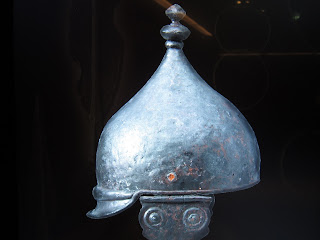"After about 400 BC, Celtic artisans
began seeking inspiration in Greek and Etruscan art, choosing certain motifs
and breathing into them a new and distinctive Celtic spirit. Plant imagery and circular ornaments, demons’
grimaces and mythical creatures adorned jewelry and weapons, horses and wagons.
Motifs are often more sculptural, more elegant and more individual than the
originals that inspired them, and they combine into artifacts that have an
unmistakable style. Depending on the
incidence of light and the viewer’s imagination, hidden hideous features and
grotesque faces can also be discerned.
The new style is also seen quite strikingly in coins that are a strange
and unique adaptation of their Greek and Roman models. Celtic artifacts reflect the high technical
skills of their makers, whose toolboxes often already contained instruments
similar to the tools used by artisans today."
Landesmuseum Württemberg
Increasingly, "the Celts, Etruscans, Greeks and Romans
exchanged both goods and ideas in the region of present-day Switzerland. This is attested to by imported luxury goods
and by the use of writing, with inscriptions using the north Etruscan alphabet
(or in other places, Greek or Latin letters)
The Celtic languages were part of the
Indo-European language family.
Continental Celtic languages were spoken on the European mainland and by
the Galatians in Asia Minor. They are
now extinct. Insular Celtic languages,
however, are still spoken in Ireland and in parts of Britain and France." Landesmuseum Zurich
The grave marker below is an Celtic inscription in north Etruscan letters: teromui kalui






No comments:
Post a Comment